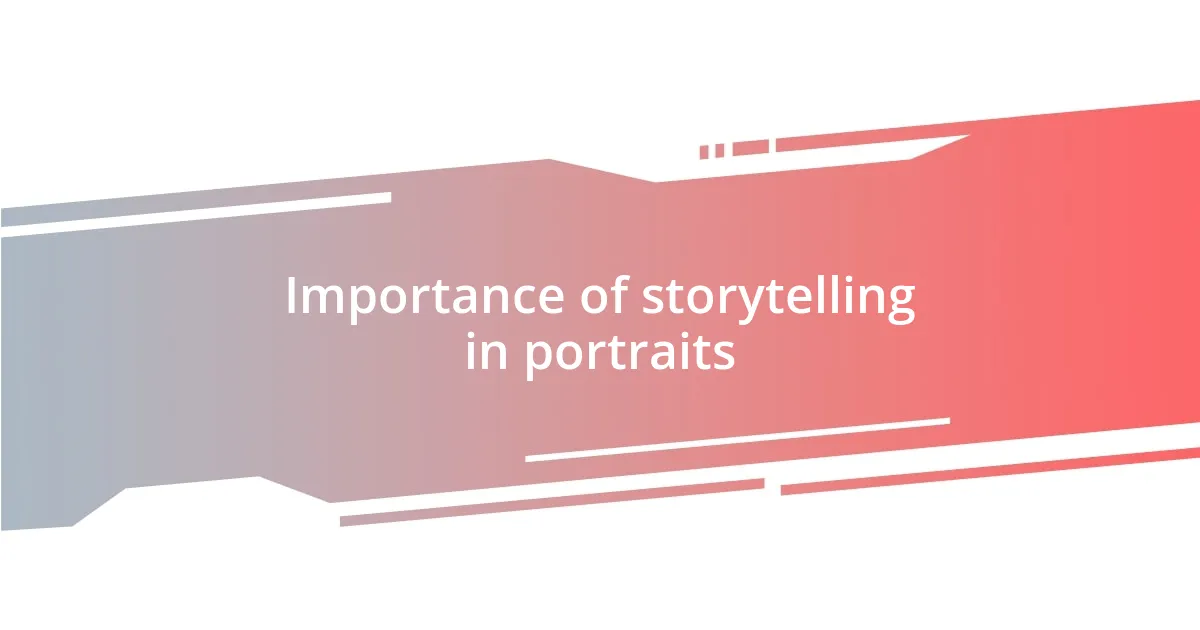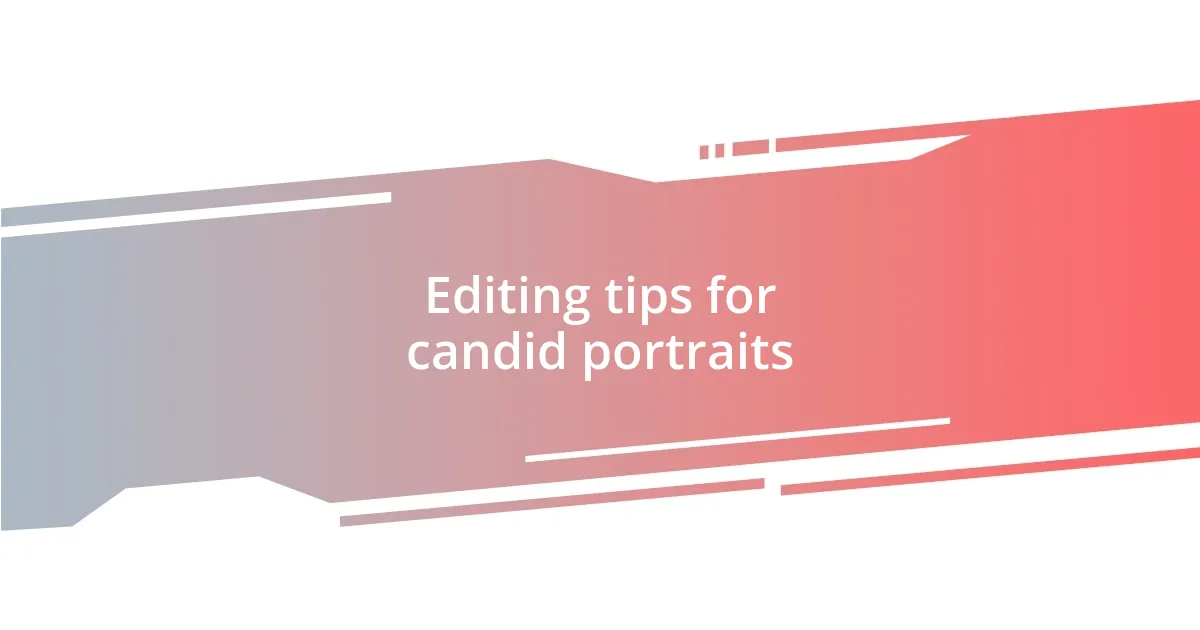Key takeaways:
- Candid portrait photography captures genuine emotions and intimate moments, creating art that resonates personally with viewers.
- Storytelling is essential in portraits, as context and expressions enhance the emotional connection between the subject and the observer.
- Choosing the right environment and techniques, such as building rapport and being unobtrusive, greatly influences the authenticity of candid shots.
- Editing is crucial for enhancing the vibrancy and narrative of candid portraits, with techniques like exposure adjustment and thoughtful cropping making a significant impact.

Understanding candid portrait photography
Candid portrait photography is all about capturing genuine moments, revealing the true essence of a person without the constraints of posed smiles or artificial settings. I remember a time at a family gathering when I snapped a photo of my grandmother laughing uncontrollably at a shared joke. It felt almost magical to freeze that spontaneous joy in time; the image told a story far deeper than any posed portrait could convey.
In essence, candid portraits allow photographers to delve into the emotions and personalities of their subjects. Have you noticed how often a simple glance or an unguarded expression can reveal so much? Personally, I find that the best portraits happen when the subject is immersed in what they love—whether it’s a child playing or a friend lost in thought. These fleeting moments are genuine reflections of their spirit, making candid shots not just photographs, but pieces of art that resonate on a personal level.
What truly sets candid photography apart is the intimacy it fosters between the photographer and the subject. I often feel more like a storyteller than a photographer, observing and waiting for that special moment. Do you see the beauty in capturing people as they are, in their natural state? It’s this raw honesty that transforms a simple portrait into something memorable and meaningful.

Importance of storytelling in portraits
Capturing the story behind a candid portrait can transform a simple image into a powerful narrative. I once photographed a friend during a sunset, her face illuminated with golden light while she gazed thoughtfully into the distance. That moment captured not just her beauty, but a story of reflection and dreams, illustrating how a portrait can evoke emotions and tell tales that words often cannot express.
Storytelling in portraits goes beyond just the moment being captured; it involves the emotions and experiences that the image conveys. While attending a local festival, I snapped a candid shot of a musician lost in his world as he played. The image spoke volumes—about passion, dedication, and the joy music brings. This simple act of recording authenticity is what makes storytelling so essential in portrait photography, allowing viewers to connect with the subject’s journey through their expression.
Furthermore, the context surrounding a portrait can enhance its storytelling aspect. I recall capturing a mother dancing with her child in a park, and that scene echoed love, joy, and the innocence of childhood. Each candid shot serves as a snapshot of life, connecting the observer to a narrative that resonates with the human experience. When I reflect on these stories woven into photographs, it reaffirms my belief that a candid portrait is not just about freezing time, but sharing a piece of someone’s life.
| Aspect | Details |
|---|---|
| Emotional Connection | Storytelling evokes feelings, linking the viewer to the subject’s experience. |
| Context Matters | Where and how a portrait is taken adds layers to its narrative. |
| Authenticity | Candid portraits capture real moments, presenting a truer representation of subjects. |

Choosing the right environment
Choosing the right environment for candid portraits significantly influences the authenticity of the images. I remember an outdoor picnic with friends where I captured moments as they interacted naturally. The lush greenery and casual atmosphere allowed everyone to relax, leading to some of the most genuine smiles and laughter on camera. This experience made me realize that the surroundings can either enhance or hinder the spontaneity of the moment.
When considering the right setting, think about elements like lighting, background, and the overall vibe. Here’s some criteria that I often keep in mind:
- Natural Light: Good lighting adds warmth and depth, enhancing the portrait’s emotional impact.
- Familiarity: Choosing a place where subjects feel comfortable can lead to relaxed, candid expressions.
- Story-Worthy Background: An interesting backdrop can complement the subject, adding context to their story without overpowering it.
- Quiet and Space: A less crowded area allows for more focus, minimizing distractions that could stifle genuine interactions.
- Personal Connections: Locations that hold significance for the subject often evoke sincere emotions, resulting in profoundly candid moments.

Techniques for capturing genuine emotions
To truly capture genuine emotions, I find that getting to know your subject is pivotal. Once, I spent an afternoon with a model prior to our shoot, sharing stories and laughs over coffee. This casual interaction helped break down barriers, which made it easier for her to express authentic feelings during the portrait session. When subjects are comfortable, their emotions naturally shine through, creating an honest representation that’s hard to replicate.
Another technique I’ve found effective is to remain unobtrusive during the shoot. I remember standing off to the side while capturing a family reunion, allowing them to interact without my presence becoming a focal point. The candid moments—children playing, laughter shared, and tender connections—unfolded beautifully because they were being themselves, unaware of the lens. This technique reinforced my belief that genuine emotions arise when people feel free to be who they are.
Lastly, timing is everything. I learned this during a visit to a friend’s wedding. I knew the emotional highlights like the first dance and speeches would be key moments, but I also made it a point to catch quieter, unscripted interactions. These often led to some of my favorite images, filled with pure joy and heartfelt connections. Capturing the right moment can reveal layers of emotion that scripted poses rarely convey. So, what do you think? Does your heart resonate with spontaneous emotions as much as mine does?

Tips for interacting with subjects
One essential tip for interacting with subjects is to actively listen to them. During a recent shoot, I worked with an artist who was initially shy about the camera. I noticed that when I asked specific questions about her artwork and listened closely, she began to open up about her creative process. This dialogue not only fostered trust but also translated into genuine moments captured on camera. How can you ensure your subject feels heard during your next interaction?
Another strategy that works wonders is using humor to ease tension. While photographing a family session, I cracked a light joke about the classic ‘serious family photo’ pose. The laughter that followed resulted in a cascade of relaxed smiles and candid moments. It’s fascinating how laughter can bridge the gap between formality and connection, isn’t it? Just remember, humor should be natural and appropriate to your subject’s comfort level.
Being aware of body language is crucial. I recall a time when I shot a couple’s engagement photos and observed them interacting quietly before I approached. Their subtle gestures and glances spoke volumes; I let them be for a moment longer, allowing their genuine affection to reveal itself. This awareness can help you decide when to step in for a closer shot or when to observe from a distance to truly capture the essence of the moment. After all, isn’t it those unscripted interactions that tell the richest stories?

Editing tips for candid portraits
Editing candid portraits can be a delightful yet challenging process. I often find that adjusting exposure and contrast can really bring out the vibrancy and emotion in a shot. For instance, during one of my editing sessions, I noticed that brightening up the shadows in a candid family photo made their laughter look even more infectious. It’s those subtle adjustments that can transform a nice picture into something truly special.
Another important aspect is color correction. I remember working on a set of candid shots taken at sunset, where the warm hues made the skin tones flat. By gently adjusting the color balance, I was able to enhance the warmth without overwhelming the natural beauty of the moment. It’s an effective reminder that, while we want to preserve authenticity, a little tweaking can enhance the overall feel of the image. Do you also see how color correction can breathe life into your portraits?
Don’t overlook the power of cropping. During a recent project focused on candid interactions at a café, I captured beautiful moments but found some distractions at the edges of the frame. By cropping those nuisances out, the images felt more intimate and focused on the genuine emotions shared between friends. It’s amazing how a simple crop can change the entire composition and narrative. What do you think—doesn’t a tighter frame often lead to deeper storytelling?

Showcasing candid portraits in portfolios
Showcasing candid portraits in portfolios is all about highlighting those raw, genuine moments that tell a story. I remember selecting photos for my portfolio and feeling drawn to the images where subjects just let their guard down. For instance, I included a shot of a father and daughter laughing together, a moment of pure joy that instantly connected with viewers. How can one frame convey such emotion? It’s in those unguarded seconds that true character shines through.
When compiling these portraits, the context of each shot can amplify its impact. In one of my portfolio reviews, a mentor pointed out how the setting could influence the perception of a candid moment. For example, the ambient light filtering through a café window not only adds a warm glow but also complements the subject’s relaxed demeanor. Have you considered how your backgrounds can enrich the stories you’re telling with your candid shots?
I’ve found that variety makes a portfolio more compelling. Mixing up the expressions and contexts, from joy to contemplation, creates a more dynamic experience for the viewer. I once curated a series that included everything from vibrant street scenes to quiet introspective moments. It struck me how this range not only showcases my versatility as a photographer but also invites the audience to feel a spectrum of emotions. What stories do the candid moments in your collection tell?















